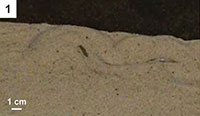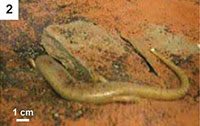FIGURE 1. 1, The sand skink Chalcides ocellatus. 2, Sand skink engaged in sand swimming near the sediment surface.

FIGURE 2. 1, Initial stratification of a terrarium filled with ten, 1-cm-thick layers of fine-grained sand. 2, Vertical cut through a core of undisturbed 1-cm-thick layers of coarse-grained sand.

FIGURE 3. Videos of the burrowing techniques of Chalcides ocellatus. 1, Burrowing by sand swimming or intrusion. 2, Burrowing by excavation. Click on image to activate animation.
FIGURE 4. 1, A sequence of surficial mounds and depressions in an experiment with alternating sand grain sizes. 2, A terrarium showing the homogenization of the upper 2 cm of fine-grained sand.

FIGURE 5. 1, Surficial sinuous bilobate trail (SSBT) in medium-grained sand with an enlarged view (insertion). 2, SSBT in coarse-grained sand. 3, A subsurficial sinuous trail from the lower portion of a core from fine-grained sand. 4, SST from the upper portion of a core from fine-grained sand.

FIGURE 6. 1, Truncation of the upper 2 cm of medium-grained sand (at arrow) and an infilled surficial depression. 2, An isolated U-shaped divot with a sharp boundary in fine-grained sand. 3, An isolated U-shaped divot with a gradational boundary in medium-grained sand. 4, Connected U- to V-shaped divots with gradational boundaries in medium-grained sand. 5, A sharply defined flame structure (arrow) and an accompanying U-shaped divot in fine-grained sand. 6, A small flame structure (arrow) in coarse-grained sand.

FIGURE 7. 1, Open burrow produced by Chalcides ocellatus in a terrarium with 20% sediment moisture. 2, The open burrow at day 12 of the trial. 3, The resulting biogenic structure from the collapse of the open burrow on day 14 of the trial.




